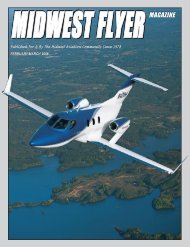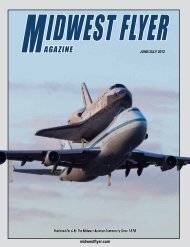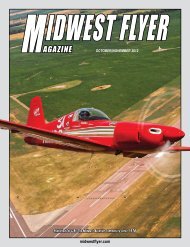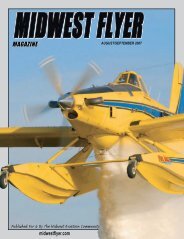AGAZINE - Midwest Flyer
AGAZINE - Midwest Flyer
AGAZINE - Midwest Flyer
You also want an ePaper? Increase the reach of your titles
YUMPU automatically turns print PDFs into web optimized ePapers that Google loves.
Wings of Hope<br />
by Melissa Kinsey<br />
Several months ago, in<br />
a sparsely populated<br />
region of Nicaragua,<br />
Wings of Hope pilot Clint<br />
Hanley received a ham radio<br />
call requesting medical<br />
transport for a man in a<br />
remote village who had<br />
developed acute appendicitis.<br />
The man would almost<br />
certainly die if his appendix<br />
ruptured. Hanley and his wife,<br />
Marilyn, carefully preflighted<br />
their medical air transport (MAT)<br />
plane, a 1966 Cessna 172. They<br />
removed one of the passenger seats<br />
to accommodate a stretcher. Minutes<br />
later, Hanley was flying above a dense<br />
swathe of rainforest, broken only by<br />
clouds and serpentine rivers.<br />
Staying in constant radio contact<br />
with his wife during the flight, Hanley<br />
arrived in less than half an hour to<br />
WENK AVIATION INSURANCE AGENCIES<br />
Since 1932<br />
The most time-honored<br />
Aviation Insurance Agency<br />
in the industry!<br />
Founded by WWI pilot, Sam Wenk,<br />
and now guided by his son,<br />
grandson and granddaughter,<br />
plus 12 other pilot-agents...<br />
15 highly-trained agents to guide you<br />
on the proper coverages and limits.<br />
Respected by the companies themselves,<br />
by their clients and by the industry...<br />
Jets, Turbines, Pistons<br />
Student Pilot or ATP<br />
Mechanics, Airports, Flight Schools...<br />
“Our Clients Love Us!<br />
You Will Too!”<br />
1-800-225-W-E-N-K<br />
Offices In Illinois, Wisconsin & Florida.<br />
Our 79th Year!!!<br />
Licensed In 48 States.<br />
26 AUGUST/SEPTEMBER 2010 MIDWEST FLYER M<strong>AGAZINE</strong><br />
A Cessna 172 gives the Miskito Indians in Nicaragua, Wings of Hope.<br />
pick up the patient, a 170-lb. father<br />
of three whose abdomen was now<br />
visibly inflamed and distended. As the<br />
man was being carried to the aircraft,<br />
the stretcher suddenly collapsed. The<br />
poor guy fell head first, and someone<br />
managed to catch him just before his<br />
head hit the ground. Even so, the pain<br />
from the jolt knocked him out cold.<br />
The patient regained consciousness,<br />
and they proceeded to the hospital,<br />
where a surgeon performed a<br />
successful appendectomy.<br />
Marilyn, a registered nurse,<br />
and Clint work in partnership with<br />
Wings of Hope to serve the Miskito<br />
Indians of northeastern Nicaragua.<br />
Wings is a nonsectarian, nonpolitical,<br />
not-for-profit charity with bases in<br />
the United States and more than 40<br />
other countries. Out of an abundance<br />
of caution, its pilots observe FAA<br />
regulations whether they’re evacuating<br />
a patient from Branson or Burma.<br />
FAA regs call for all non-ambulatory<br />
patients (that is, those who can’t walk)<br />
to be transported on a litter (stretcher)<br />
that meets certain specifications. This<br />
rule is intended to ensure the safety of<br />
the patient, as well as the safe egress of<br />
seated passengers.<br />
But aircraft stretchers, which<br />
are made to be lightweight and<br />
compact, consequently lack durability.<br />
Each time a hinge gives out, a new<br />
stretcher must be purchased, since<br />
the manufacturer does not sell<br />
replacement parts. Sometimes the<br />
air ambulance must be<br />
grounded until funding can<br />
be procured. As long as<br />
the plane remains tethered,<br />
stranded patients may die<br />
of injuries and treatable<br />
illnesses.<br />
But Frank Sybert, one of<br />
about 500 Wings of Hope<br />
volunteers in St. Louis,<br />
Missouri, came up with<br />
a solution. Using nothing<br />
but his mechanical skills, a<br />
machining tool, a solid brick<br />
of aluminum, and a dash of<br />
ingenuity, he fashioned an<br />
identical replacement hinge.<br />
“The standard hinges are die cast,”<br />
Sybert explains. “The new hinges are<br />
made of pure metal, so they’re about<br />
four times stronger.”<br />
Sybert, a modest, unflappable<br />
man who speaks only when he has<br />
something downright important to<br />
say, is 76 years old – incidentally,<br />
that’s the average age of a Wings of<br />
Hope volunteer. He had no AutoCAD<br />
program with which to model the new<br />
hinge, but he did have 50 years of<br />
toolmaking and machining experience<br />
for General Motors and the U.S. Air<br />
Force, including 4 years of Korean<br />
War service. Sybert scoffed at the<br />
idea of relying on fancy software.<br />
He simply sat down with the broken<br />
hinge and a pencil and paper, drew<br />
out a plan, and got busy fabricating a<br />
prototype.<br />
One day a week, Sybert reports<br />
to work inside the 16,000-sq. ft.<br />
hangar and adjacent office building<br />
in suburban St. Louis that serve as<br />
the headquarters for Wings of Hope.<br />
With its metal halide lights gleaming<br />
on the spotless white linoleum, the<br />
hangar might be mistaken for a BMW<br />
showroom if it weren't for the Cessna<br />
206s and Piper Arrows housed there.<br />
The volunteer pilots, EMTs, and<br />
other staff at Wings of Hope operate<br />
the only free air ambulance in the<br />
<strong>Midwest</strong>. In addition, from 150 bases<br />
in Central and South America, the<br />
Caribbean, Africa, Southeast Asia,<br />
and elsewhere, the group provides
















